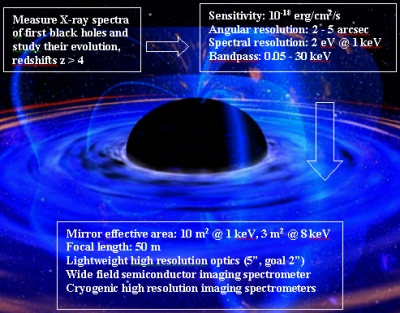X-ray Optics for XEUS
 |
|
XEUS Mission Science Requirements |
The XMM-Newton optical design would require 16 tons of nickel excluding the support structures. The XEUS mirrors need to be made within a mass constraint of 2 tons, which requires a factor 8 reduction in mass in addition to the improvement in the optical qualities. Due to the large mass of the optics the XEUS mission in its original configuration required multiple launches and assembly at the ISS. The technology development is leading to a much lighter spacecraft which can be launched on a single Ariane 5, be self deployed and no longer requires to be in orbit with the ISS.
All previous technologies lie along a similar trend of increasing mass density with increasing resolving power. Future missions like Constellation-X and XEUS need a ground-breaking development to break this dependency. The mass reduction for the same collecting area will allow more sensitive observations.
Chandra uses highly polished monolithic glass. XMM-Newton uses replicated nickel shells. SCI-AT embarked on the development of new technologies like high performance silicon pores and glass microchannel plates.
Optics Developments must not only achieve the science requirements but also be feasible to manufacture in a cost effective manner. In this respect the integration of optics must be simple and the ability to mass produce the optics with a high reliability are important factors. The silicon pore optics lends itself to this scaling advantage.
The low cost and reduced weight optics will allow XEUS to be launched into an L2 orbit 1.5 million miles from Earth. This greatly reduces the operations costs in comparison with the original mission concept involving assembly at the ISS. The XEUS mission concept foresees two spacecraft, the optics spacecraft and a detector spacecraft flying in formation.
